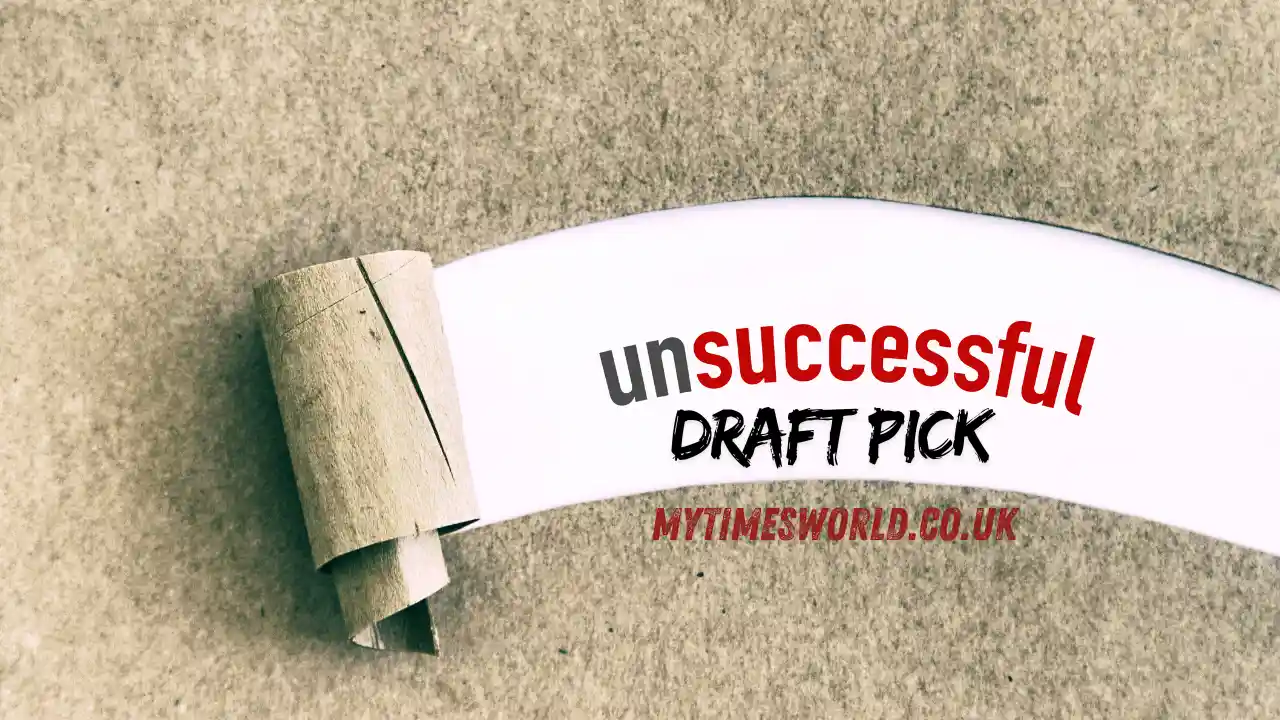Introduction
Draft picks are an integral part of building a successful sports team. They represent the future, the hope, and the potential for a franchise to rise to greatness. However, not all draft picks pan out the way teams hope. In fact, some end up being costly mistakes, leaving teams scrambling to recover. This article explores everything you need to know about unsuccessful draft picks, from the factors leading to them, the impact they have on teams, and strategies to avoid making the same mistakes in the future.
What Are Draft Picks?
Draft picks are selections made by sports teams to acquire new talent, usually from college or international leagues. These players are expected to bring fresh energy, skill, and potential to the team, often filling crucial roles that need strengthening. In leagues like the NFL, NBA, MLB, and NHL, draft picks are a key part of team-building strategy.
The Importance of Draft Picks in Sports
Draft picks are more than just names on a roster; they are investments in the team’s future. A successful draft pick can elevate a team from mediocrity to championship contention, while an unsuccessful one can set a franchise back for years. The stakes are high, and the pressure to get it right is immense.
Overview of Successful vs. Unsuccessful Draft Picks
Successful draft picks are players who not only meet but exceed expectations. They become core members of their teams, contributing to wins, and often becoming stars in their own right. On the other hand, unsuccessful draft picks fail to live up to the hype, whether due to poor performance, injuries, or other factors. These picks often become cautionary tales in sports history.
Factors Leading to Unsuccessful Draft Picks

Lack of Scouting and Research
Inadequate Player Evaluation
One of the primary reasons for unsuccessful draft picks is poor scouting and evaluation. Teams might focus too much on a player’s physical attributes while overlooking other crucial aspects like mental toughness, work ethic, and adaptability. Without thorough research, teams can easily miss red flags that could indicate potential issues down the line.
Overlooking Character and Off-Field Issues
A player’s character and off-field behavior are just as important as their on-field performance. Teams that overlook these aspects may find themselves dealing with players who lack discipline, have legal issues, or fail to mesh with the team culture. These factors can significantly derail a player’s career and, by extension, the team’s success.
Injuries and Physical Health
Pre-existing Conditions
Injuries are a major concern when drafting new players. Some players enter the draft with known health issues or a history of injuries. Teams that take the risk of drafting these players often find themselves facing the consequences when those injuries resurface, limiting the player’s availability and effectiveness.
Injury Prone Players
Even players who appear healthy can turn out to be injury-prone. This unpredictability is a gamble for any team, and when it doesn’t pay off, it results in an unsuccessful draft pick. The impact is felt not just on the field but also in the locker room, as teams struggle to adjust to the absence of key players.
Pressure and Expectations
High Expectations from Teams and Fans
The pressure on draft picks to perform can be overwhelming. Teams, fans, and the media often place enormous expectations on these young athletes, sometimes unrealistically so. When players fail to meet these expectations, they are quickly labeled as busts, which can affect their confidence and performance even further.
Media Hype and Its Impact
Media hype can be a double-edged sword. While it can boost a player’s profile, it can also create unrealistic expectations. When a player doesn’t live up to the media’s portrayal, the backlash can be harsh, and the player’s career can suffer as a result.
Poor Fit with Team System
Misalignment with Coaching Style
Even the most talented players can fail if they’re not a good fit for their team’s system. Coaches have specific strategies and styles, and a player who doesn’t align with that can struggle to find their place on the team. This misalignment can lead to reduced playing time, poor performance, and eventually being labeled as an unsuccessful draft pick.
Incompatibility with Team Strategy
Teams have long-term strategies that guide their drafting decisions. A player who doesn’t fit into this strategy can become a liability, even if they are talented. For example, a team that focuses on a defensive style may struggle to integrate an offensive-minded player, leading to a poor fit and, ultimately, an unsuccessful draft pick.
Famous Examples of Unsuccessful Draft Picks
NFL: JaMarcus Russell
JaMarcus Russell is often cited as one of the biggest draft busts in NFL history. Drafted first overall by the Oakland Raiders in 2007, Russell was expected to be the franchise quarterback. However, his lack of work ethic, poor performance, and off-field issues led to a short and disappointing career.
NBA: Greg Oden
Greg Oden was the first overall pick in the 2007 NBA Draft, selected by the Portland Trail Blazers. Despite his immense potential, Oden’s career was plagued by injuries. He played only 105 games over seven seasons, making him one of the most disappointing draft picks in NBA history.
MLB: Mark Appel
Mark Appel was the first overall pick in the 2013 MLB Draft, chosen by the Houston Astros. Despite high expectations, Appel never made it to the major leagues, struggling with performance and injuries throughout his minor league career. He is often cited as one of the biggest busts in MLB history.
NHL: Alexandre Daigle
Alexandre Daigle was the first overall pick in the 1993 NHL Draft, selected by the Ottawa Senators. Despite being highly touted as the next big star, Daigle never lived up to the hype. His lackluster performance and eventual exit from the NHL make him one of the most infamous draft busts in hockey history.
How Unsuccessful Draft Picks Impact Teams
Financial Costs
Salary Cap Implications
Unsuccessful draft picks can have significant financial implications for teams. High draft picks often come with hefty contracts, and when those players fail to perform, the team is left with a large financial burden. This can affect the team’s ability to sign other players and manage the salary cap effectively.
Wasted Resources
Drafting a player involves a considerable investment of time, money, and resources. When a pick doesn’t pan out, all of that investment is essentially wasted. This can set a team back, forcing them to spend more on finding replacements or trying to trade the unsuccessful pick.
Team Performance and Morale
On-Field Performance Decline
A failed draft pick can lead to a decline in team performance. When a key position is filled by a player who doesn’t deliver, the team’s overall performance can suffer. This can result in more losses, lower standings, and missed playoff opportunities.
Impact on Team Chemistry
Team chemistry is crucial for success, and an unsuccessful draft pick can disrupt this balance. Whether it’s due to poor performance, off-field issues, or a bad fit with the team, these players can negatively impact the morale and cohesion of the group.
Long-Term Franchise Impact
Missed Opportunities
Every unsuccessful draft pick represents a missed opportunity. The player that could have been chosen instead might go on to have a successful career elsewhere, leaving the original team wondering what might have been. These missed opportunities can haunt a franchise for years.
Rebuilding Challenges
Unsuccessful draft picks can make rebuilding a team even more challenging. When a team invests in a player who doesn’t deliver, they are forced to go back to the drawing board, often without the resources or draft capital they initially had. This can prolong the rebuilding process and delay the team’s return to competitiveness.
Strategies to Avoid Unsuccessful Draft Picks

Improved Scouting and Analysis
Advanced Analytics and Data Use
One of the best ways to avoid unsuccessful draft picks is by improving scouting and analysis. Teams are increasingly using advanced analytics and data to evaluate players more accurately. This approach can help identify potential risks and better predict a player’s future performance.
Incorporating Psychological Evaluations
Beyond physical and technical skills, psychological evaluations can provide insights into a player’s mental toughness, adaptability, and fit with the team’s culture. Incorporating these evaluations into the draft process can help teams make more informed decisions.
Focus on Player Development
Long-Term Development Plans
Drafting is just the first step; developing a player is equally important. Teams that focus on long-term development, providing the necessary support and resources, are more likely to see their draft picks succeed. This includes everything from coaching and training to mentorship and personal development.
Balancing Immediate Needs with Future Potential
Teams must balance their immediate needs with the potential of draft picks. While it’s tempting to draft players who can contribute right away, investing in players with long-term potential can pay off in the future. This approach requires patience and a clear development strategy.
Flexibility in Drafting Approach
Trading Down for Better Value
Sometimes, the best pick is not the highest one. Teams that trade down can acquire more picks or valuable assets, increasing their chances of drafting successful players. This strategy also reduces the pressure on a single pick, spreading the risk across multiple selections.
Considering Multiple Draft Scenarios
Draft day is unpredictable, and teams that prepare for multiple scenarios are better equipped to make the right decisions. By considering various outcomes and being flexible in their approach, teams can avoid the pitfalls of unsuccessful draft picks.
Conclusion
The unpredictability of draft picks makes them both exciting and nerve-wracking for teams and fans alike. While some players become legends, others fade into obscurity, leaving teams to wonder what went wrong. However, by learning from past mistakes, improving scouting and analysis, and focusing on player development, teams can increase their chances of drafting successfully and avoid the costly mistakes that have plagued so many franchises.
FAQs
What is the biggest reason for an unsuccessful draft pick?
The biggest reason for an unsuccessful draft pick is often a lack of thorough scouting and evaluation. Without a deep understanding of a player’s abilities, character, and fit with the team, it’s easy to make mistakes in the draft.
Can a team recover from a failed draft pick?
Yes, a team can recover from a failed draft pick, but it may take time. Recovery often involves making smart trades, focusing on player development, and being flexible in future draft strategies.
How do teams typically scout for draft picks?
Teams scout for draft picks through a combination of methods, including watching game footage, attending live games, conducting interviews, and using advanced analytics to assess a player’s potential.
Are there any successful players who were initially considered failed draft picks?
Yes, there are players who struggled early in their careers but eventually found success. These players often work hard to overcome initial setbacks, proving that early struggles don’t always define a career.
How do fans typically react to unsuccessful draft picks?
Fans’ reactions to unsuccessful draft picks can vary, but they are often disappointed or frustrated, especially if the pick was highly anticipated. However, over time, some fans may come to understand the challenges and unpredictability of the draft process.







Be First to Comment